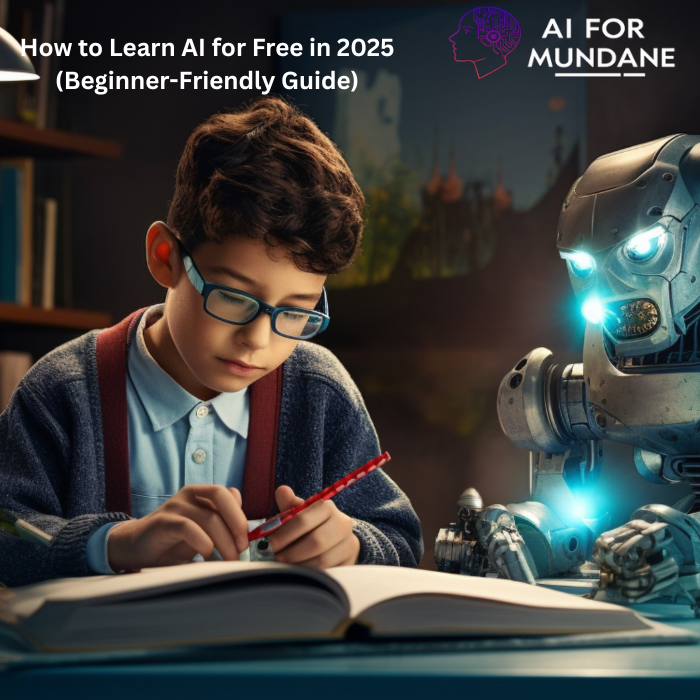How to Learn AI for Free in 2025 (Beginner-Friendly Guide)
Artificial Intelligence (AI) is one of the most exciting and in-demand fields in the world right now. From ChatGPT to self-driving cars, AI is everywhere—and the best part? You can start learning AI for free, even if you’re a complete beginner.
In this guide, we’ll walk you through how to learn AI step by step using completely free resources. No programming background? No problem. Let’s make AI accessible to everyone.
Step 1: Understand What AI Really Is
Before diving into tools or code, it’s important to get a basic understanding of what AI means.
AI (Artificial Intelligence) refers to machines or software systems that can mimic human intelligence. These systems learn from data, recognize patterns, solve problems, and make decisions.
Main types of AI include:
Narrow AI: Focused on specific tasks (e.g., Siri, Google Maps)
Generative AI: Creates content like text and images (e.g., ChatGPT, DALL·E)
Machine Learning: AI systems that improve automatically through data
Deep Learning: A subfield of machine learning involving neural networks
Free resource to get started:
Elements of AI – A globally recognized, beginner-friendly course from the University of Helsinki
Step 2: Learn Key Tools and Concepts
You’ll often hear terms like:
Machine Learning (ML): Algorithms that learn from data
Neural Networks: AI models inspired by how our brains work
Data Science: Prepares, analyzes, and visualizes data
NLP (Natural Language Processing): How machines understand human language
Free resource:
Google’s Machine Learning Crash Course – Includes videos, exercises, and practical ML concepts
Step 3: Take Free Beginner Courses
Several high-quality courses are available at no cost:
AI for Everyone by Andrew Ng (Coursera – audit mode free)
Machine Learning Specialization (Coursera)
Introduction to AI by IBM (edX)
CS50’s Introduction to AI (Harvard on edX)
Kaggle Learn – Short tutorials with code
Fast.ai – Practical deep learning for those with some coding experience
Most courses are self-paced, and many allow you to audit for free without paying for certification.
Step 4: Learn by Building Simple Projects
Applying your knowledge is the fastest way to improve. Try:
A spam email classifier
A movie recommendation system
A chatbot using GPT APIs
A digit recognizer using MNIST dataset
Free platforms to use:
Google Colab – Write and run Python code in the browser
Kaggle – Access real datasets and notebooks
Hugging Face – Explore pre-trained AI models
Step 5: Join AI Communities
Learning with others makes the journey easier and more fun. Communities can help you:
Ask questions and get answers
Stay updated with the latest AI tools
Get feedback on your projects
Communities to explore:
Reddit: r/learnmachinelearning
Discord servers: Hugging Face, DeepLearning.AI
LinkedIn: Join AI-related groups and follow practitioners
Twitter/X: Follow popular AI researchers and developers
Step 6: Keep Practicing and Stay Curious
AI is a fast-moving field. Stay engaged by:
Reading case studies or blogs on AI in your industry
Watching videos on how ChatGPT or other models work
Trying new tools and mini-projects each month
You don’t have to master everything at once—just keep learning steadily.
Bonus: Beginner-Friendly AI Tools to Explore
These tools let you experience AI even if you’re not building models:
ChatGPT – Ask for explanations, debug code, or brainstorm ideas
Notion AI – Summarize notes, draft emails, and boost productivity
Canva Magic Design – Generate social media designs with text prompts
Copy.ai / Jasper – AI writing tools for content creators
These apps are great for exploring how AI can assist you in everyday life or work tasks.
Your AI Learning Plan Summary
Learn the basics of AI: Start with Elements of AI
Understand key terms: Use Google’s Crash Course
Take beginner-friendly courses: Try Coursera, edX, Kaggle
Build small projects: Use Colab, Hugging Face, Kaggle
Join online communities: Learn, ask questions, and stay updated
Use AI tools daily: Try ChatGPT, Canva, and others to apply concepts
Final Thoughts
You don’t need a degree, years of experience, or expensive software to learn AI in 2025. With free online resources, supportive communities, and curiosity, anyone can start their AI journey today. Whether you’re a student, professional, teacher, or just curious—AI is for everyone.
Start small, stay consistent, and have fun exploring the future.
Follow AI for Mundane for more easy-to-follow AI tips, tools, and tutorials to help you grow in the world of artificial intelligence.






